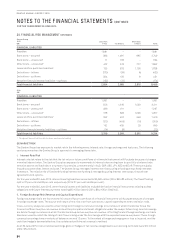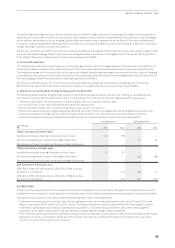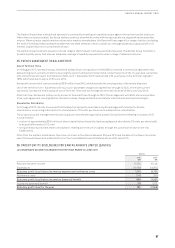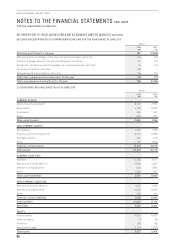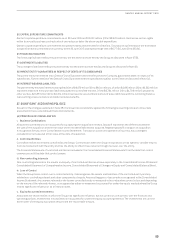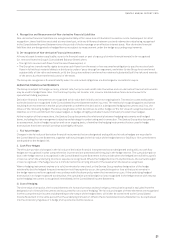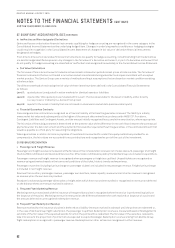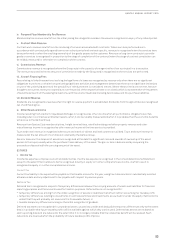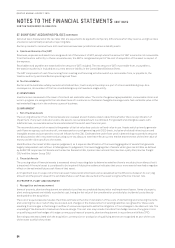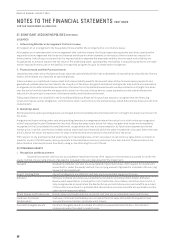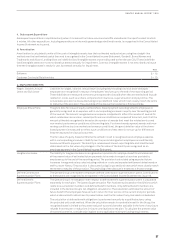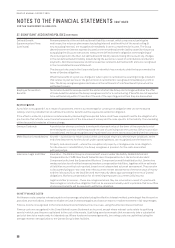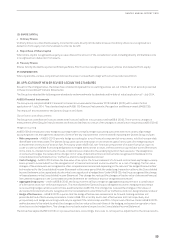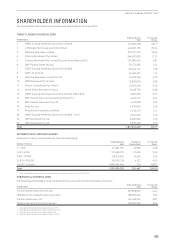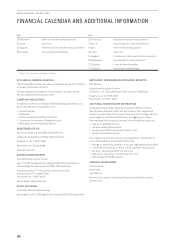Qantas 2015 Annual Report Download - page 95
Download and view the complete annual report
Please find page 95 of the 2015 Qantas annual report below. You can navigate through the pages in the report by either clicking on the pages listed below, or by using the keyword search tool below to find specific information within the annual report.
NOTES TO THE FINANCIAL STATEMENTS CONTINUED
FOR THE YEAR ENDED 30 JUNE 2015
94
QANTAS ANNUAL REPORT 2015
37. SIGNIFICANT ACCOUNTING POLICIES CONTINUED
Deferred tax is measured at the tax rates that are expected to be applied to temporary differences when they reverse, using tax rates
enacted or substantially enacted at reporting date.
Qantas provides for income tax in both Australia and overseas jurisdictions where a liability exists.
ii. Goods and Services Tax (GST)
Revenues, expenses and assets are recognised net of the amount of GST, except where the amount of GST incurred is not recoverable
from the taxation authority. In these circumstances, the GST is recognised as part of the cost of acquisition of the asset or as part of
the expense.
Receivables and payables are stated with the amount of GST included. The net amount of GST recoverable from, or payable to,
thetaxation authority is included as a current asset or liability in the Consolidated Balance Sheet.
The GST components of cash flows arising from investing and financing activities which are recoverable from, or payable to, the
taxation authority are classified as operating cash flows.
iii. Tax Consolidation
Qantas and its Australian wholly owned controlled entities, trusts and partnerships are part of a tax consolidated group. As a
consequence, all members of the tax consolidated group are taxed as a single entity.
(F) INVENTORIES
Inventories are measured at the lower of cost and net realisable value. The costs of engineering expendables, consumable stores and
work in progress are assigned to the individual items of inventories on the basis of weighted average costs. Net realisable value is the
estimated selling price in the ordinary course of business.
(G) IMPAIRMENT
i. Non-financial Assets
The carrying amounts of non-financial assets are reviewed at each balance date to determine whether there is any indication of
impairment. If any such indication exists, the asset’s recoverable amount is estimated. For goodwill and intangible assets with
indefinite lives, recoverable amounts are estimated at the end of each financial year.
The recoverable amount of an asset is the greater of its fair value less costs to sell and value in use. Assets which primarily generate
cash flows as a group, such as aircraft, are assessed on a cash generating unit (CGU) basis, inclusive of related infrastructure and
intangible assets and compared to net cash inflows for the CGU. Estimated net cash flows used in determining recoverable amounts
are discounted to their net present value using a pre-tax discount rate that reflects current market assessments of the time value of
money and the risks specific to the assets.
Identification of an asset’s CGU requires judgement, as it requires identification of the lowest aggregation of assets that generate
largely independent cash inflows. In Management’s judgement, the lowest aggregation of assets which give rise to CGUs as defined
by AASB 136: Impairment of Assets are the Qantas Domestic CGU, Qantas International CGU, Qantas Loyalty CGU, Qantas Freight
CGU and the Jetstar Group CGU.
ii. Financial Assets
The carrying value of financial assets is assessed at each reporting date to determine whether there is any objective evidence that it
is impaired. A financial asset is considered to be impaired if objective evidence indicates that one or more events have had a negative
effect on the estimated future cash flows of that asset.
An impairment loss in respect of a financial asset measured at amortised cost is calculated as the difference between its carrying
amount and the present value of the estimated future cash flows discounted at the asset’s original effective interest rate.
(H) PROPERTY, PLANT AND EQUIPMENT
i. Recognition and measurement
Items of property, plant and equipment are stated at cost less accumulated depreciation and impairment losses. Items of property,
plant and equipment are initially recorded at cost, being the fair value of the consideration provided plus incidental costs directly
attributable to the acquisition.
The cost of acquired assets includes the initial estimate at the time of installation of the costs of dismantling and removing the items
and restoring the site on which they are located, and changes in the measurement of existing liabilities recognised for these costs
resulting from changes in the timing or outflow of resources required to settle the obligation or from changes in the discount rate. The
unwinding of the discount is treated as a finance charge. The cost also may include transfers from hedge reserve of any gain or loss
on qualifying cash flow hedges of foreign currency purchases of property, plant and equipment in accordance with Note 37(C).
Borrowing costs associated with the acquisition, construction or production of qualifying assets are recognised as part of the cost
of the asset to which they relate.


